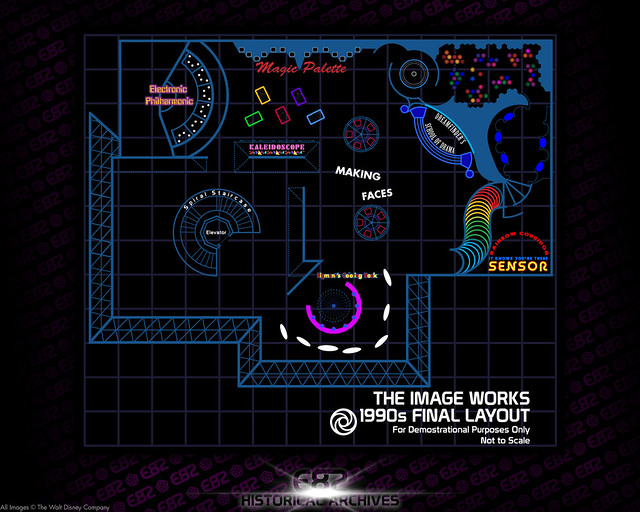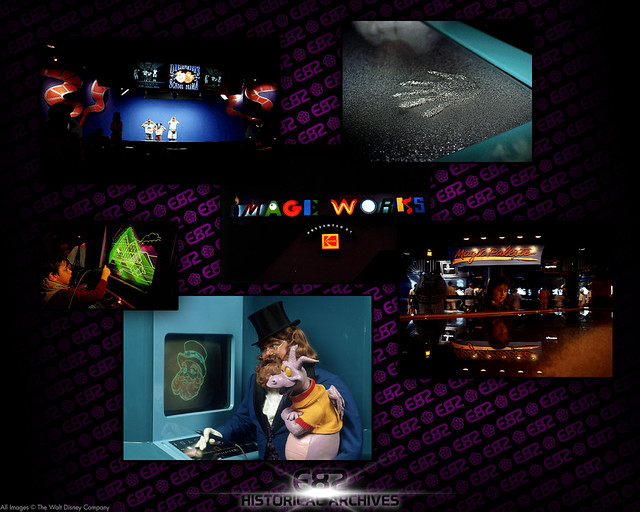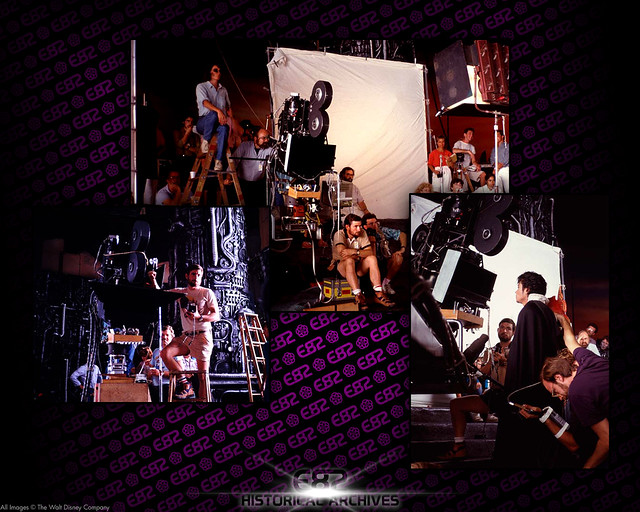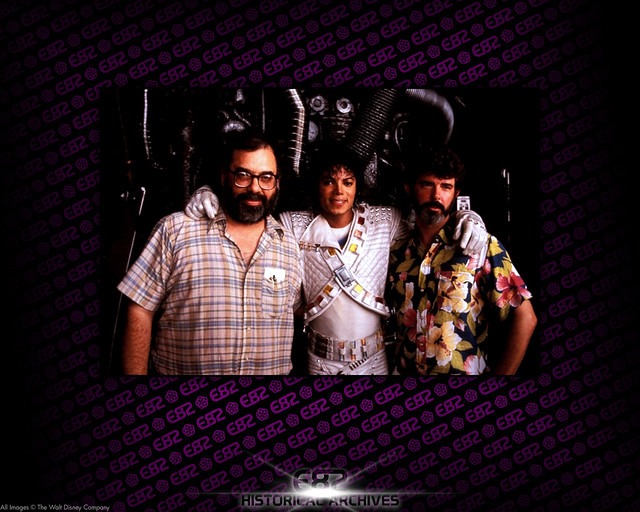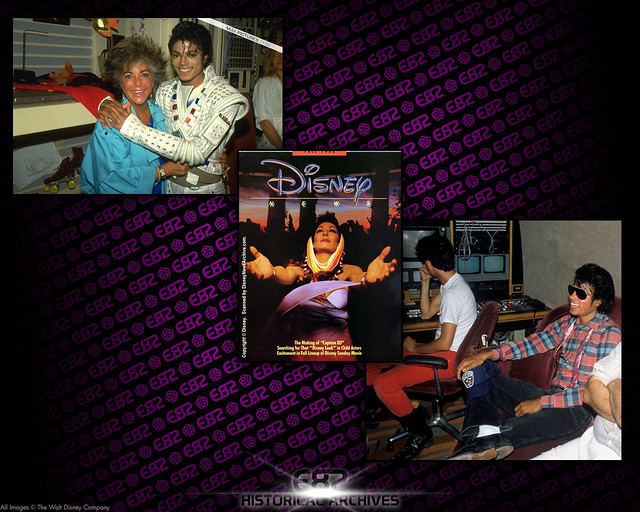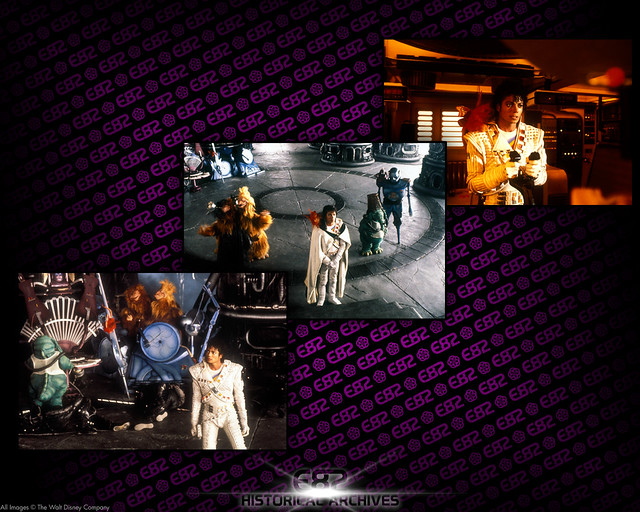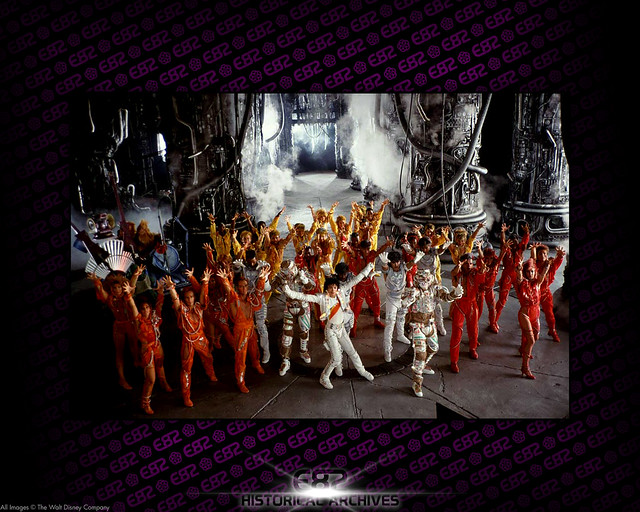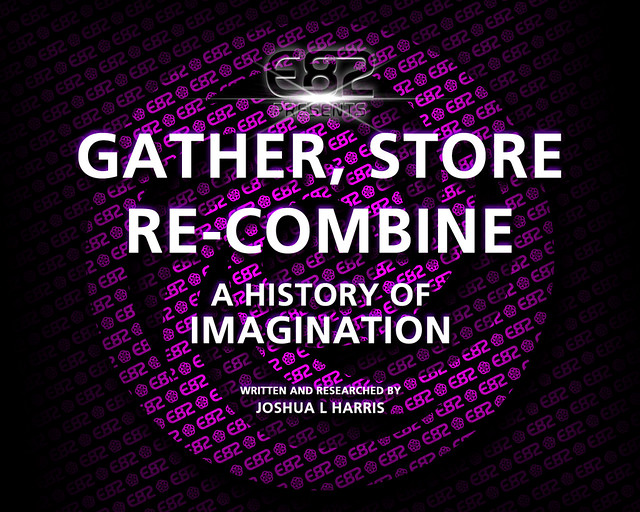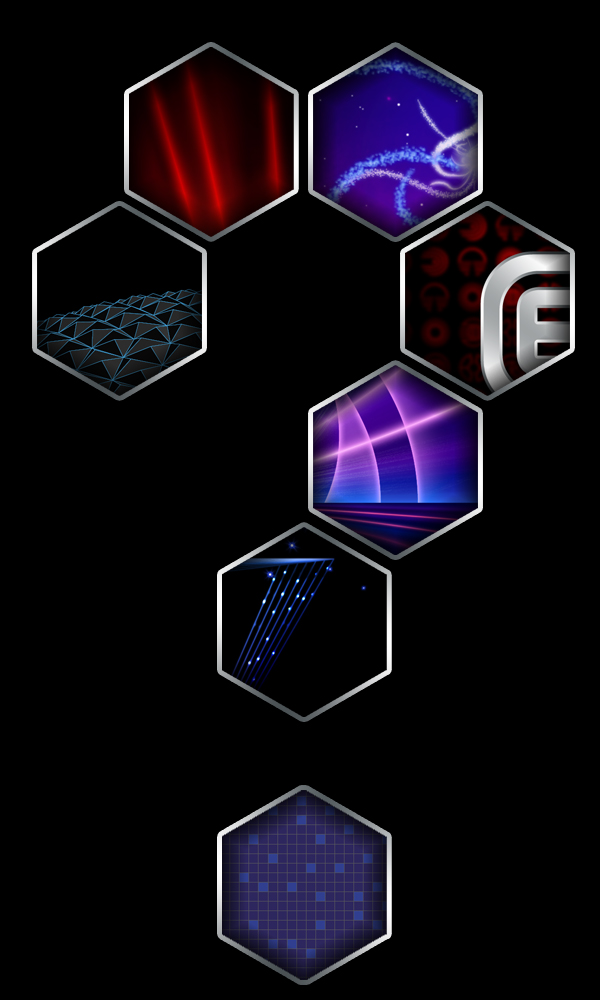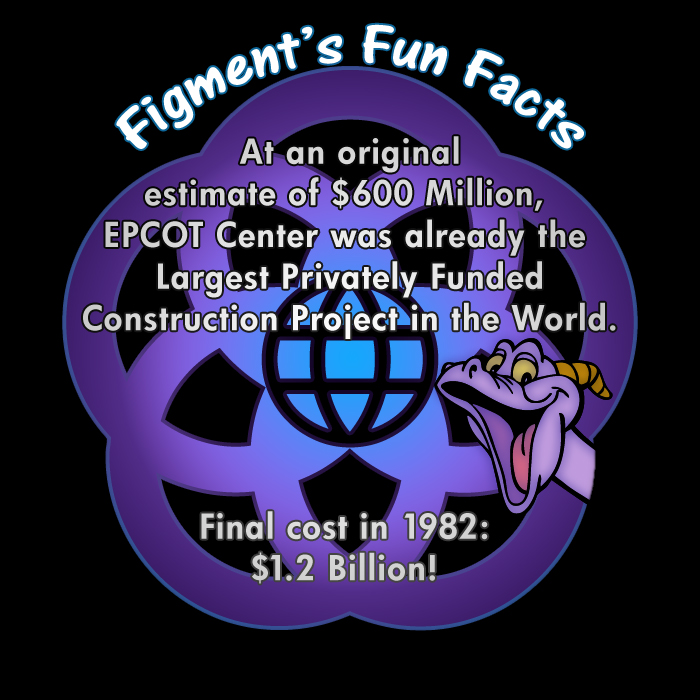OUR STORY SO FAR...
Disneyland’s entirely new land, Discovery Bay, is put back on the shelves to inspire many great achievements of Imagineering for the next two decades. One of these was a “Gallery of Illusions” featuring Professor Marvel and is dragon breeding experiments. The Professor and one of his baby dragons eventually became the Dreamfinder and Figment. At the Same time, genius Imagineer Tony Baxter creates yet another failed concept for EPCOT Center’s “The Land” pavilion based on ecology and featuring glass crystal architecture that would itself be recycled into the glass pyramids of Journey Into Imagination the pavilion destined to become the Fantasyland of EPCOT Center. The Pavilion contains three major attractions, The Journey Into Imagination ride, the Image Works interactive exhibit and a really tripped-out 3-D movie featuring a new and sophisticated technique for creating 3-D films. The process is awesome, the music is great, and the film no one cares to watch twice.
The Image Works…Very Well.
Scientists, Artists, Authors, and Imagineers get the future wrong all the time. We don’t have time machines, I can’t make a down payment on a flying car, its 2010 and there’s no Discovery mission to Jupiter’s moon Europa, and I’ve been waiting for a Maglev to Mesa Verde for quite some time now. What it is amazing is when they get it right!
Here’s once again is the original description…
THE IMAGE WORKS
Described by Richard R. Beard
The Ride is so delightful and engaging that, when it ends, we are left with a compelling urge to create something. This reaction is spontaneous, but it is naturally provided for by the canny show planners. Immediately ahead is a magic hall called Image Works, where we may try our hand at a wondrous array of creative tools of the future, inspired by our Journey into Imagination.
The Warm and welcoming atmosphere is designed to overcome any hesitation caused by the sight of all that electronic wizardry. And, of course, once you dive in, you’ll be hooked. Just grab, for example, a “paintbrush” in one of the consoles of the Magic Palette and let fly on your individual screen. Paint anything you like, in “colors” you’ve never seen before. There’s a pot of rainbow colors, another of Cheshire Cat tails. One “ink” gives the impression of Cubism, another of circular candy strips. The harder you press, the thicker the line, and if you slip up, dip your brush into “ease”, which will wipe it out, and start all over.
Have you ever had a secret yen to conduct and orchestra? Move over to the Electronic Philharmonic, take your place on your own private podium, and face the music. With a wave of your hand, you can control the volume of the strings section, the brasses, the woodwinds, the percussion-and watch magical notes flow from the instruments.
Leaving your symphony-hopefully not unfinished-you wander about like a child in an enchanted toyshop.
Choose the elements to create a gargantuan image in a kaleidoscope: with a turn of knob, change the pattern, pick out a swirl of color for a liquid effect.
When you press the keys of a beautiful Bubble Organ, they not only bubble, they also bring forth brightly colored spheres that you can combine and overlap and mix and meld on a screen.
Play with the deliciously prickly Pin Screens, then take your turn at the Light Writer, where you, too, can create your own laser show. On the of four great plexiglass “planets,” you control the swirling, spiral laser patterns, selection size, speed and shape.
Now on to the Sensor Maze, subtitled “It Knows You’re There,” which provides an artistic funhouse experience. A tunnel of neon rings assigns you a personal color, which escorts you through the giant tube to the Vibrating Mirror. Made of Mylar, the crinkling, flexible mirror, lit be a strobe, shows you coming and going in an unending pattern of zany distorts. Among other oddities of the maze is the Lumia, a voice activated light show in a giant sphere that responds to the pitch and modulation of your voice, and Stepping Tones, where your tread triggers not only color and light effects but weird and wonderful sound effect as well: a jungle squawk her, a chord there, beeps or growls or spooky night wails.
The centerpiece of the Image Works is probably Dreamfinder’s School of Drama in the middle of the hall. It’s divided into three “theaters,” each one of which puts you and your friends on center stage in a variety of situations. Using the blue-screen technique, the apparatus projects your image onto pre-filmed background settings. While you act out and appropriate scene, spectators react to your performance.
The Time Machine places you in various time warps-perhaps in a cave, threatened by ferocious prehistoric beasts, or in Elizabethan England, or in the Wild West, or on a spaceship under attack by alien creatures. Sneak Preview stars you in trailers for current television shows. Stunt Show superimposes you image on scenes of dire peril: on a fraying rope bridge teetering precariously between two Himalayan peaks; on the wing of a biplane about to execute an unscheduled barrel roll.
The Image Works is spectacularly successful in its goal-giving you a chance to express yourself in ways you’d never thought possible. You may become so absorbed in its myriad pleasures that, were not for the promise of still another presentation around the corner, you would find it difficult to leave.
The Importance of Flow
Transitions are a hallmark of Imagineering design. In many cases, these are ether found inside a single attraction or themed environments. Very rarely does this type relationship occur between attractions. Whereas, one experience naturally leads to another and to my knowledge this has only occurred in twice in the history of theme park design. (1) Journey Into Imagination (the Pavilion) is one of these examples. The original concept was basically Ride, Play, & Watch: RIDE the Attraction, PLAY in the Image Works and finally WATCH an Imaginative 3-D movie in the Magic Eye Theater.
Looking back at the Image Works, the exhibits are amazingly forward thinking, in many ways The Image Works was over 25 years ahead of its time. (28 years to be exact.) Most of its well remembered attractions have evolved into practical applications for creative expression and entertainment.
The following is a list accurate predictions made by Image Works exhibits.
Light Writer
There are well over 200 products on the market specializing in at-home laser light shows, ranging in price from over $800 to less than $25.
Stepping Tones
Although very few of us have musical carpets, a sophisticated version Dance Dance Revolution can’t be too far in the future.
Electronic Philharmonic
With Xbox 360’s “Kinect,” Gesture driven games are about to become a reality. I’m sure than with its debut this Christmas conducting your favorite Music and Films Scores can’t be far behind. (It’s like Guitar Hero for air conductors).
Magic Palette
This was the most popular of all Image Works exhibits, and it’s not hard to see why. With Imaging software like Adobe’s Photoshop (and Illustrator which is the most accurate comparison) and a touch screen or a tablet we can live the EPCOT Center Future! (2)
In the 17 years of its existence, the original Image Works would change time and time again as the popularity of exhibits fluctuated based on guest reaction, technological advances and durability. For a complete visual history of the Image Works, I highly recommend viewing the following documentary produced by noted videographer Martin Smith…
Imagination 82 - The Original Imageworks from Martins Videos on Vimeo.
Image Works was well loved by all EPCOT Center Fans. We all had our favorite games up there. I myself recall having a particular fondness for the Electronic Philharmonic, (so much so, that I just plain ignored all other activities and always when straight there). In the years that followed its closing, Image Works would become a source of intrigue. This is because of what this extinct attraction failed to do: …disappear!
But that’s a story for another time.
A TALE OF TWO MICHAELS
With the opening of EPCOT Center, Walt Disney Productions had, in one stroke, reached its greatest achievement and it worst nightmare. The public, and most importantly Wall Street had looked at the opening of the park as the completion of Walt’s Final Dream. Special emphasis should be placed on the word Final. The basic line of thinking is that with Walt’s last assignment “from the grave” fulfilled Walt Disney Productions had reached an end pass. Although in 1982 there were several pavilions left to complete (Imagination included), and Tokyo Disneyland still under construction, most outsiders (and some insiders) looked upon Disney as quickly reaching creative bankruptcy.
In 1984, this ideology came to fruition when the entire company was to be dissolved. Roy E. Disney, not one to allow this to occur, left the Company to begin searching for new leadership. He found it in a seemingly creative executive from Paramount Studios and an unsold Vice President of Warner Brothers. Michael Eisner and Frank Wells took the reins of company and quickly decided to diversify the company in both assets and development.
Among those Eisner sought out were individuals that had similar interests in family entertainment from across the spectrum. To this end, Michael and Frank began courting the biggest names in Hollywood and with one attraction got them all! In Randy Bright’s (3) Disneyland: The Inside Story Randy tells the story far better than I can…
Just before the Christmas holidays in 1984, WDI’s Bongirno and Dick Nunis were discussing a call they had received from new Disney president Frank Wells. “What would your designers want to do if they could develop an attraction with Michael Jackson?” Wells has asked. Bongirno got an immediate response from his staff. Disney had developed the most sophisticated 3-D camera system in the world, a 70-millimeter system that had been used to create a stunning film for EPOCT Center ion Walt Disney World. Starring Michael Jackson in a 70-millimeter, 3-D rock adventure at Disneyland seemed to be perfect casting.
Shorty after the holidays, WDI received its first visit from one of the Park’s biggest fans. Accompanied by Jeffery Katzenburg, the head of Walt Disney Pictures, Michael Jackson met with the WDI design Staff and listened to the 3_D film proposal. “I think it’s a really great idea,” he observed, “but I’d like to do it with George and Steven.” Everyone around the table recognized the Hollywood shorthand for George Lucas and Steven Spielberg. Lucas had already been working with WDI on several ideas that might bright his Star Wars mythology to Tomorrowland. The timing seemed opportune.
WDI designer Rick Rothschild headed up a concept team that sketched out three different screen scenarios for Jackson and Lucas to consider at the next meeting. They both picked the same story-Jackson would play space pilot named Captain EO, whose mission was to bring music and dance to a distant planet to break the spell of a wicked queen.
Produced by Lucas and directed by Francis Ford Coppola, the production brought together an impressive array of creative talent from around the entertainment industry. Yet the show would not be limited to the screen. “While the film was being produced on one side of town, “says WDI’s Rick Rothschild, “we had to create a theater that was so laden with special effects that the audience would feel that they had been drawn right into the movie.”
Rothschild’s team created smoke effects that would roll into the theater when Jackson’s spaceship crashed. They built a fiber optic star field that enhanced and extended the film’s own galaxy beyond the screen’s dimensions. The installed laser units behind the screen that would fire over the audience’s heads during the show, “Rothschild said. “But producing the effects on the film nearly drove us crazy.”
The project nearly drove everybody else crazy too. Schedules slipped, budgets drained, marketing plans changed, and frustrations flourished. In other words, it was just like any other Disneyland project.
The opening night of “Captain EO,” however, was quite unlike any other in the long and storied past of Disneyland. It set off a party that kept the Park open for sixty straight hours- a genuine Hollywood-style premiere, which through the Eisner/Katzenburg film connections, brought out more entertainment celebrities than any other time since the park’s grand opening more than three decades earlier.
Walt Disney, Michael Jackson, and Healthy Obsession
Anyone reading this is either inspired, entertained, obsessed or all of the above by the unique brand of artistry that Walt Disney created or cultivated. Michael Jackson is no exception. Like many of us, it starts with a unique set of circumstances. In many cases, our love for Disney begins with a need for escapism. For his entire life, Michael felt a tremendous burden of his Orpheus-ness beginning with his oppressive father. Born in 1958, by the time Michael was “of age” (typically 3 to 9 years old) he was watching re-releases of the biggest classics like Snow White and the Seven Dwarfs (1967), Pinocchio (1962) and most importantly Peter Pan (1969). It is this film/character Michael would most identify with for the rest of his life. (4) (5)
Later on in life, (as it does for a lot of us) entertainment transforms into collection and research. Michael went so far as to call Biographer, Bob Thomas (6) to ask as many questions as possible about Walt Disney the man himself. With the help of Thomas, Michael when even further by tracking down a very elderly Hazel George (7) and asking her questions about her old boss. Michael’s Collection of Disney memorabilia is legendary and could fully be an exhibit in its own right.
The first time Michael worked for the Studio was as host for Disneyland’s 25th Anniversary TV Special. Before and after working on Captain EO, Michael was a regular visitor to all Disney theme parks, and in the late ninety’s was often taking up residence in the Disneyland Paris Hotel. Although he never wrote a book on the subject, Michael Jackson would surely be greatly respected by Disney Academics everywhere.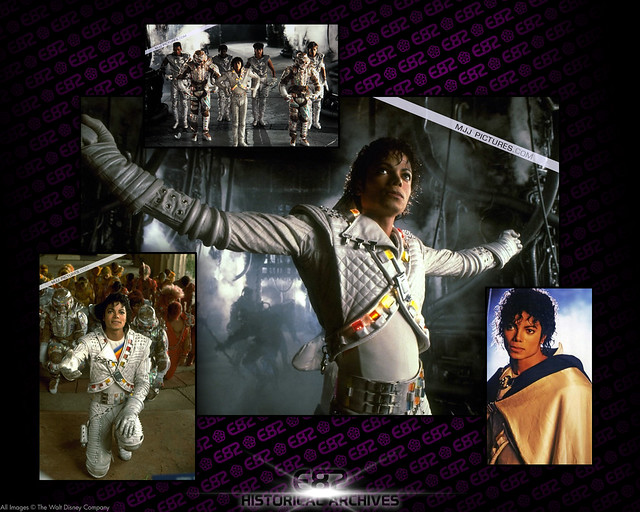
Although Captain EO held its World Premiere at Disneyland, like many big budget films and plays it made its debut “out-of-town” and six days before at EPCOT Center. The park hours were extended to 10:00pm that Friday and Saturday to accommodate the “Captain EO Blast-Off party” where special bands, singers and dancers performed in front of the Journey into Imagination all afternoon. The festivities were capped by a specially produced laser show at the end of both nights. (OS 9/14/86)
The Other Michael Jackson 3D Films
When Michael Eisner charged Rick Rothschild and his team with creating the appropriate vehicle for a Michael Jackson 3D film several concepts were tired. One such concept had Michael performing a “Thriller” Style dance with the Pirates of the Caribbean. (8) The film for Captain EO is really a mix between the two remaining concepts. The first was for a Pan-like character that defeated an Ice Queen with power of music and dance, and a space opera originally titled “Intergalactic Music Man.” (9)
Ultimately, Michael Eisner’s concept worked out very well for both Disneyland and especially EPCOT Center. Up until 1986, EPCOT Center, although beautiful and futuristic, was severely lacking in energy and youthful enthusiasm. (10) Captain EO provided both and was a welcome addition to the list of EPCOT offerings. This is also the first time that the Eisner publicity machine was used to its maximum ability. As part of the media campaign, the new Disney Channel broadcasted a 45 minute special on “The Making of Captain EO” hosted by Whoopi Goldberg. The show itself was nothing short of spectacular and the sheer number of in-theater effects really did elevate the status of this film to a true Attraction.
IN OUR FINAL CHAPTER, we’ll explore the evolution of the Imagination Institute and speculate about future journeys.
In Case You missed it...
Gather, Store, Re-Combine: A History of Imagination (Part 1)
Foot Notes
(1) The two occurrences have been in attractions created for the original EPCOT Center. And, this concept applies to all of the original Disney-MGM Studios. In that, one first experiences the history of Hollywood (The Great Movie Ride and Superstar Television,) then moves to the back of park for The Making Of and processes surrounding modern screen productions.
(2) On a personal note, my research and graphic design combined to enlighten me as to the prophetic wonders of the original Image Works. Many a time I’m working on a vector logo (or a Figment:) and thinking about how the Magic Palette is so closely related to my calling and the careers of many others.
(3) Randy Bright was quite literally the heart and soul of EPCOT Center, much more on this later on in E82. For my fellow “LOSTies” out there Randy is “Jacob” in the E82 Project.
(4) Interestingly enough Peter Pan’s first re-release was in Michael’s birth year 1958.
(5) Whenever anyone writes anything about Michael Jackson and Disney you have to mention the appropriately named Neverland Ranch. There’s your quota!
(6) Bob Thomas wrote the “Walt Disney: An American Original” Originally released in 1976 it was the definitive biography on Walt for 30 years until the release of “Walt Disney: The Triumph of the American Imagination” by Neal Gabler in 2006.
(7) Hazel George was the studio nurse and Walt’s closest confidante. At the end of every work day she would treat Walt’s old polo injury by giving him a diathermy treatment or a massage. During this time he would discuss many of the events of the day. She would later become one of Thomas’ primary resources in writing his Biography.
(8) Ironically Michael did end-up doing “Thriller” in the Haunted Mansion for his unrealized “This Is It” Concert.
(9) For a more complete telling of this story please visit Jim Hill Media.
(10) 1986 was a very important year for EPCOT Center. Not only did Captain EO open, but Spaceship Earth was changed to include a more cohesive and uplifting ending with “Tomorrow’s Child” and new narration by Walter Cronkite. Lastly, four years after opening Future World was finally completed with the opening of The Living Seas.


